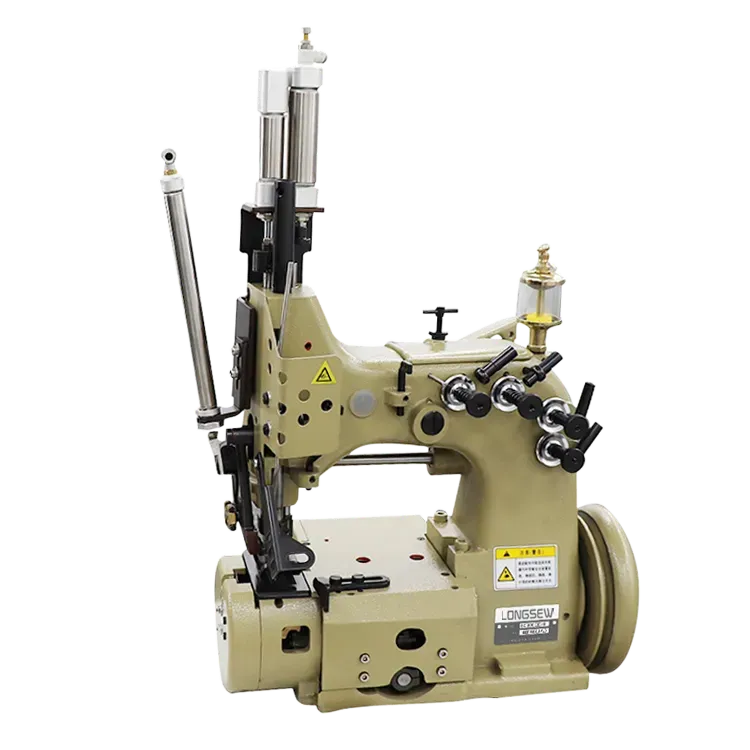Maximizing Production with FIBC Sewing Machines: Tips for Maintenance and Optimization
Flexible Intermediate Bulk Containers (FIBCs) have become an essential part of modern logistics, used across industries for transporting and storing bulk goods like chemicals, food, and grains. The key component of FIBC production is the sewing process, which ensures the bags are durable and can withstand heavy loads. To maximize the efficiency and longevity of Bag FIBC Sewing Machines, proper maintenance and optimization strategies are crucial. This essay will explore the importance of maintaining these machines and offer practical tips for optimizing production.

Understanding the Role of FIBC Sewing Machines
FIBC sewing machines are specialized equipment designed for stitching large, heavy-duty fabric used in the manufacturing of bulk bags. These machines must be capable of handling thick and durable polypropylene or other woven fabrics that make up the FIBC bag. Depending on the complexity of the bag design and the material being used, the sewing process can vary, but generally, FIBC sewing machine are responsible for joining the fabric panels, reinforcing the seams, and stitching the loops or handles that facilitate lifting.
Regular Maintenance for Longevity and Performance of Bag FIBC Sewing Machines
To ensure that FIBC sewing machines operate at peak efficiency, regular maintenance is essential. Maintenance activities should be performed systematically, with attention to detail, to avoid unexpected breakdowns and prolong the lifespan of the machines.
FIBC sewing machines are mechanical systems with moving parts, so regular lubrication is crucial to reduce friction, prevent wear and tear, and ensure smooth operation. Check the machine's manual for recommended lubricants and schedules. Proper lubrication of the needle bar, hook, and feed dog mechanisms is necessary to ensure smooth movement and avoid machine jams or skipped stitches.
The needle is the most important part of any sewing machine. For FIBC bag producing line, which deal with tough fabrics, the needle must be strong and capable of withstanding the stresses of thick materials. Regularly inspect the needle for signs of wear or bending and replace it when necessary. Additionally, the thread quality must be consistent to prevent machine malfunctions, thread breakage, or poor seam integrity. Using high-quality, industrial-grade thread is crucial for ensuring strong seams.
Accumulated dust, fabric debris, and thread lint can interfere with machine operation and lead to overheating, jams, or breakage. Cleaning the machine regularly, especially around the bobbin and needle area, is an essential part of routine maintenance. A soft brush or compressed air can be used to remove lint from tight spaces. Ensure the machine’s tension mechanisms are also free of dust and debris to maintain optimal stitch quality.
Optimization Tips for Increased Productivity of Bag FIBC Sewing Machines
In addition to regular maintenance, optimizing the operation of FIBC sewing machines is critical for maximizing production efficiency. Here are some tips to enhance productivity:
A well-trained operator can make a significant difference in the performance of an FIBC sewing machine head. Operators should be familiar with machine settings, proper threading techniques, and troubleshooting common issues. Providing training on how to handle the specific fabrics and patterns used in FIBC production will also help minimize errors and maximize the speed and quality of sewing.
FIBC sewing machines vary in terms of speed and functionality. Opting for high-speed machines, especially those equipped with automatic thread trimming, can greatly increase production output. These machines are designed to handle high volumes and can often reduce downtime by automatically completing certain tasks, like cutting the thread or adjusting tension.
Maximizing the production efficiency of FIBC bag sewing machinery requires a combination of regular maintenance and strategic optimization. By following best practices for machine care, such as proper lubrication, needle inspection, and tension adjustment, manufacturers can ensure that their machines continue to operate at peak performance. In parallel, optimizing machine settings and providing thorough training for operators will help reduce downtime and increase production speed. In a high-demand industry like FIBC manufacturing, these measures are critical for staying competitive and ensuring product quality, all while minimizing operational costs.
-
Leather Sewing Machine: The Industrial Standard for Tough MaterialsNewsJul.18,2025
-
Sail Making Machine: Heavy-Duty Stitching for Industrial and Marine NeedsNewsJul.18,2025
-
Sling Sewing Machine: The Backbone of Heavy-Duty FabricationNewsJul.18,2025
-
Leather Sewing Machine: Precision for Heavy-Duty StitchingNewsJul.18,2025
-
Big Bag Sewing Machine: Powering the Future of Bulk PackagingNewsJul.18,2025
-
FIBC Sewing Machine: Essential Equipment for Bulk Bag ProductionNewsJul.18,2025
-
Heavy Duty Leather Sewing Machine: A Must-Have for Professional LeatherworkNewsMay.28,2025





























